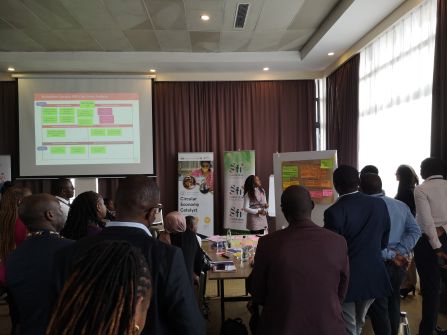13 New Approaches for Financing Circular Economy Enterprises
| Date |
Date
|
Access to finance is one of the most common challenges cited by growing enterprises worldwide: in Kenya, 64% of enterprise rely on their own savings for starting capital.[1] The lack of access to external capital to grow their business hinders circular economy enterprises from developing and marketing their services and products and from proving their business models through economies of scale.
The commercial banking system – with a wide network of branches, institutional knowledge of the SME sector, and structures for relationship management and follow-up – are well placed to unlock green and climate finance for SMEs. In May, 2023, the Circular Economy Catalyst brought together teams from 13 commercial banks and 1 development bank in Kenya to explore the topic of financing in the circular economy and develop financial instruments that can be implemented to reach circular economy SMEs.
Commercial banks in Kenya, recently tasked to address climate risks in their portfolios by the Central Bank of Kenya, see climate change as both a risk (42% agree or strongly agree), but even more importantly an opportunity for their sector (88% agree or strongly agree). Furthermore, 83% of the participants see circular economy solutions as an interesting tool to achieve the climate goals of their institution.
Why is finance not reaching circular economy enterprises?
Despite the strong interest in circular economy solutions for addressing climate change, finance is not reaching enough circular economy enterprises. While SMEs often cite burdensome collateral requirements and high interest rates as reasons for this, banks centred on 3 main challenges: the lack of a clear pipeline of bankable projects in the circular economy, the complexity of green projects, and a low awareness on the part of the banking sector to select and support circular economy enterprises.
The Green Finance Academy: Focus Circular Economy held by adelphi in collaboration with the Kenyan Bankers Association with support from the IKEA Foundation aimed to address these three challenges. By digging into case studies for circular economy businesses, bringing SMEs to speak about their business models, and reviewing existing and potential de-risking mechanisms, the Academy sought to raise awareness of bank teams of the opportunities to finance these projects, and to co-design instruments that respond to enterprise needs.

What can we do to address this gap?
As a result, 13 new instruments were developed to enable financing of circular economy enterprises, and ranged from revolving funds in the construction sector to concessional loans for enterprises managing and valorising agricultural waste. Participants identified 3 key levers in their instruments that were determined crucial: capacity building for circular enterprises to increase bankability, financing from development finance institutions and/or the bank’s own balance sheet to provide loans at concessional prices, and technical assistance to the banks to de-complexify green technologies and business models.
On the last day of the training, banks pitched their instruments to wider ecosystem stakeholders – including circular economy SMEs, incubators and accelerators, development finance institutions, and networks. Next, banks will be presenting their results internally to put their ideas into action!
Have ideas about how to increase access to finance for circular economy enterprises?
Reach out to us at hello thecircularcatalyst [dot] com (hello[at]thecircularcatalyst[dot]com)
thecircularcatalyst [dot] com (hello[at]thecircularcatalyst[dot]com)
[1] * Based on Kenya Bankers Association‘s 2021 MSME Survey Report with 2949 respondents
